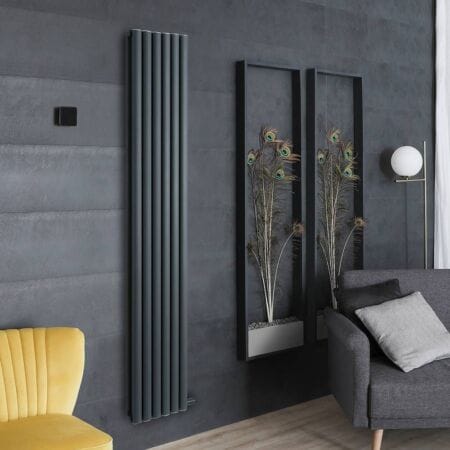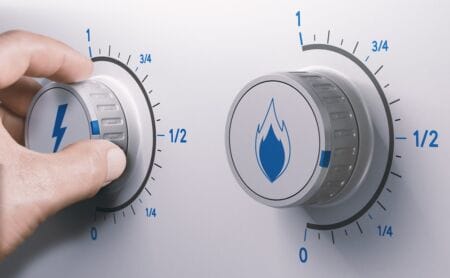Contents
ToggleUsing smart heating controls to transform home heating practices
Smart heating controls (smart thermostats, smart TRVs and connected timers) can make your home warmer when you want it, cooler when you don’t, and cheaper to run all round. In this guide, we explain how modern, smart central heating controls work, what they cost, the real‑world savings you can expect, and the pros and cons to help you choose confidently.
What are smart heating controls and how do they work?
Imagine if your central heating system had a brain – not one of those forgetful ones that leaves the oven on, but a sharp, responsive, slightly smug one that remembers your routine better than you do. Essentially, that’s smart heating.
At their core, smart heating controls are digital tools that let you manage your heating remotely, using Wi-Fi, apps, or voice assistants.
In short, a smart thermostat (plus optional smart TRVs and sensors) communicates with a receiver/hub that controls your boiler or heat source. The system automates schedules so your heating is on at the right time, optimises temperatures and can react to occupancy and weather to reduce waste.
How smart heating controls work step by step...
- Measure – Room sensors and a modern thermostat are used to track temperature and (optionally) humidity in real time.
- Decide – The controller will apply your schedule and other clever nuances (learning, load/weather compensation, geofencing).
- Call for heat – The receiver/hub instructs the boiler or alternate heat source to fire. With OpenTherm/modulating boilers it can adjust heat output too, rather than just offering on/off functionality.
- Distribute – Smart thermostatic radiator valves, or TRVs, open only in rooms that require heat (zoning). Radiators in rooms warmed up to target temperature remain switched off, so you don’t pay to heat empty spaces.
- Optimise continuously – Geofencing provides pre-heating practicality before you arrive home; open‑window detection pauses heat; weather/load compensation trims flow temperatures for efficiency.
- Review & refine – The app displays insights into trends, runtimes and usage so you can fine‑tune accordingly across the season for optimal performance.
Key features of a smart heating system
Some vital components and elements make up a well-performing smart heating system. The main hallmarks of a successful smart heating operation are as follows:
- Smart thermostats – Smart thermostats are the ringleaders – they monitor temperature, adapt to your schedule, and let you tinker with your settings from your phone. Some even detect if you’re in or out (ideal if you’re the forgetful sort).
- Smart TRVs (Thermostatic Radiator Valves) – The sidekicks. Smart thermostatic radiator valves give you room-by-room control – warm in the lounge, cool in the bedroom, sauna mode in the bathroom if you’re feeling fancy. Find out more about their their impact on performance in our article, the role of radiator valves in energy efficiency.
- Wireless timers and zoning hubs – These split your home into heating zones, so you’re not boiling the whole place just to heat the kitchen while you cook up a storm anyway.
- Geofencing and occupancy sensors – Your heating literally stalks your movements (in a helpful way) and adjusts accordingly.
- Learning schedules – The thermostat learns your lifestyle patterns and routines, and adjusts automatically over time.
- Open window detection – Pauses heating the space if a rapid temperature drop suggests a window has been opened, and extra heat is neither wanted or required.
- Weather and load compensation – Reduces flow temperature when conditions allow to reduce boiler cycling and fuel usage levels.
- App and voice control – Adjust settings remotely from anywhere; voice control works with Alexa/Google/Apple devices (brand dependent).
- Smart insights – Reports into smart system runtime, temperature fluctuations and nudges to help you cut waste and use only the amount of energy you need.
Through regular use of the above features, the Energy Saving Trust suggests savings of £110 per year can be made in UK homes that properly utilise smart heating controls.
The benefits of smart thermostats and programmable timers
Right, so they’re clever, but what does that actually do for you? Quite a lot, actually.
Learning your habits
Most smart thermostats learn when you’re in, when you’re out, and when you like things just right (Goldilocks would be proud). They’ll start to predict your ideal schedule, and you won’t even have to lift a finger. Well, maybe one finger. Now and then.
Remote control
Stuck on the train home? Unexpected night at the in-laws? Want to warm up the house from bed without risking a cold-footed floor dash? Done. Just open the app and boom – warm home radiators, wherever you are.
Energy efficiency
Using less gas and electricity isn’t just good for your wallet – it’s good for the planet. You’ll use less energy when you’re not home, and you won’t need to blast the heating for hours to catch up. It’s well worth also reading up on the best times to use your heating for maximum efficiency, and how to balance your BTU output with room size for the most efficient performance possible.
Bill savings
As aforementioned, the Energy Saving Trust suggests a smart thermostat can save you in the region of £130 per year – that’s a lot of pizza, or whatever your vice is. Especially in this economy.
How smart TRVs help with zonal heating
Welcome to the age of the microclimate. With smart TRVs, every room in your home becomes its own weather system – and you’re in charge. Just keep ‘blame it on the weatherman’ far away from your Spotify playlist.
Why use smart TRVs?
- Room-by-room control: No more heating the spare room that only sees guests once a year.
- Temperature balance: Keep the kitchen cooler while the lounge stays snug. No more thermostat tug-of-wars.
- Tailored routines: Bedroom warm at 10pm, bathroom toasty at 7am, living room cool by 11pm. Like clockwork.
With the right setup, you can divide your home into as many heating zones as you like – or at least as many as your budget allows. And the beauty is, you can change it all with a tap on your phone.
Wondering if smart TRVs are worth the hype? Have a look at our dedicated radiator valve buying guide to aid your decision.
Can smart heating really save you money?
Let’s be real – we all want to save money, especially now that the cost of heating a home can rival the price of a small used car. So, can smart heating controls genuinely help?
The numbers:
According to independent testing and government estimates:
- Smart thermostats can reduce energy usage by 10–12%
- Zoned heating can boost efficiency even more – up to 20-25% savings in some households
- Smart habits amplify your savings (think: lower overnight temperatures, geo-tracking, auto shut-off functionality)
But here’s the catch:
Smart heating tech won’t do all the work for you. If your windows are single-glazed, your insulation’s poor, or you insist on tropical temps year-round, you’ll struggle to see dramatic cuts.
Smart heating is like a gym membership. If you use it right, it works wonders. If not, it just sits there draining your bank account and making you feel guilty.
Saving money with smart heating controls: Real world examples
With the help of trusted energy usage statistics from Ofgem, we’ve compiled a collection of real-world examples that indicate how valuable smart heating controls can be for various types of households in various scenarios.
Energy usage statistics
For the purpose of the illustrations to come, we’ve obtained energy usage statistics from a number of respected energy industry sources.
- Typical gas use – Low: 7,500 kWh/yr. Medium/Average: 11,500 kWh/yr. High: 17,000 kWh/yr. (Ofgem)
- Illustrative 2025 gas unit rate (Apr–Jun 2025 price cap average) – ~6.99p/kWh (regional/quarterly variation applies; standing charges unaffected by savings). (Which?)
- Heating share of gas use (UK homes) – ~77% used for space heating (remainder made up of hot water/cooking). (Beama)
- Evidence‑based saving factors –
Smart heating controls annual bill impact
The table below demonstrates the impact smart heating controls can have on annual bills for a range of different types of households.
Household (illustrative) | Gas use (kWh/yr) | Baseline gas spend* | Smart thermostat (5%) | Smart thermostat (14%) | Smart TRVs only (~14% of total) | Combined (thermo 5% + TRVs) | Combined (thermo 14% + TRVs) |
Low (flat / 1–2 bed) | 7,500 | £524 | £26 | £73 | £73 | £95 | £136 |
Medium (3‑bed semi) | 11,500 | £804 | £40 | £113 | £111 | £146 | £208 |
High (4–5 bed) | 17,000 | £1,188 | £59 | £166 | £165 | £216 | £308 |
Smart heating controls purchase cost vs investment
A quick look into smart heating controls purchase cost against investment, exploring how long it would take to make money back on your initial outlay.
- A single smart thermostat (£130-£185):
- Medium home example: saves between £40 and £113 per year, meaning it would take anywhere from 1.5 to 4.5 years to reclaim your purchase amount depending on how engaged you are.
- Six smart TRVs (£270-£480 in thermostatic radiator valve heads):
- Medium home example: saves £111 annually, leading to a payback term of 2.5-4 years (or quicker if you add extra TRV heads/rooms or have higher usage needs).
- Thermostat + TRVs (6) (£450-£650):
- Medium home example: saves between £146 and £208 each year, for a payback period of 2 to 3.5 years.
In line with the previously cited source, the Energy Saving Trust also estimates savings of £110 per year from the simple installation and correct usage of core smart heating controls.
Smart heating savings for typical households
A few examples of smart heating savings in typical household setups. See which scenario best aligns with your circumstances…
- Work-from-home couple in a 3‑bed semi – The office/living room are kept at 20 °C on weekdays, with bedrooms at 17 °C. Their smart heating setup consists of a single thermostat with 5-8 supporting smart TRVs. Expect mid‑range combined savings.
- Young family in a 4‑bed home – Separate “kids’ bedtime” zone in effect upstairs; lower temperatures set in spare/playroom most days. The smart heating system incorporates a sole thermostat along with 8-12 TRVs. Overall savings are towards the upper end of the scale.
- Flat-share – Heat up the living space on evenings and weekends; bedrooms set to schedule individually. The smart heating system features one thermostat and 3-5 thermostatic radiator valves. Good comfort gains with modest but solid savings.
Drawbacks to consider with smart heating controls
- Installation complexity – Two‑channel systems (heating and hot water) need the right kit. Some legacy wiring will require the services of a professional.
- Older boilers & controls – Gravity hot water and certain plan types require especially careful configuration. Boiler Plus expectations apply to upgrades and replacements.
- Brand changes & app fees – Check current feature sets and any subscription requirements which could also be subject to inflation over time (e.g. tado° Auto‑Assist pricing updates and reported paid version app‑access trials).
- Privacy – Choose brands with clear GDPR statements to protect your privacy.
Embrace the smart side with BestHeating
Smart heating is more than a trend – it’s a transformation. It gives you the tools to heat your home more efficiently, save money on bills, and gain full control over your comfort no matter your level of insulation.
So, whether you’re tech-obsessed or just sick of guessing the thermostat, take the plunge. The future of home heating is here, and it’s cleverer than ever.
Don’t forget to let us know how you’ve embraced smart heating solutions. You can reach us in the comments section below, or contact us via Instagram, Facebook or X.
John is a Research Specialist for the Best Heating Advice Centre, where for over nine years he has dedicated himself to demystifying home heating for our customers. He specialises in creating clear, data-driven guides and how-to articles by collaborating directly with our team of certified heating experts and product engineers.
His work, built on a foundation of journalistic research, has helped millions of readers make confident and informed decisions about their home heating. When he’s not breaking down the heat output differentials from radiators to heated towel rails, John fancies himself as a fine football and music connoisseur.









